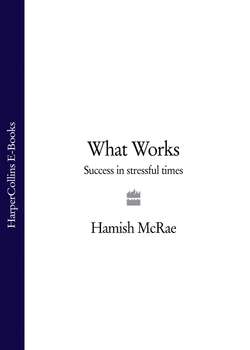Читать книгу What Works: Success in Stressful Times - Hamish McRae - Страница 16
2. WHAT ARE THE LESSONS?
ОглавлениеAs you might imagine, this is a story that has been picked over thousands of times. Every country with a sluggish economy wanted to know how to fix it, and the Irish model seemed the best one to bet on.
The problem is that this is a subtle tale. For it to be helpful as a model, you have to get beyond saying it was the result of low taxes and good education. You also have to acknowledge the mistakes that were made and finally to see how the country has set about correcting those mistakes. The way it has coped with its excesses is almost as useful to others as the success story itself.
We start with success. There have been several elements to this and the trick is to judge which of these were crucial and which merely nice to have.
The easy part, and one emulated by the new EU member states, is to be ‘business friendly’. That means low taxation. Ireland became a magnet for inward foreign investment thanks in fair measure to its low corporation taxes, 12. 5 per cent in 2009, less than half the average EU rate. For the new EU members it has been a flat-tax system, a single low rate on both individuals and companies.
While any country can cut its taxes at a stroke, the other general element of Ireland’s success, the availability of educated young people, takes time. Ireland reformed its education system back in the 1960s, improving secondary schooling and pumping money into its universities. The depression provoked longer stays in the education system producing a steep rise in the education levels of the Irish workforce which, accompanied by low wage expectation on its part, presented good value to potential employers. For many years another large part of the resulting human capital had left the country. Skilled people emigrated. But when growth did take off, that very emigration became a benefit, for people returned, thereby boosting the local labour pool but also bringing back the practical skills they had learnt working abroad.
Beyond these two core elements there is a well-known litany. Students of the Celtic tiger point to EU subsidies being spent rather more effectively. They cite deregulation of the service industries, the development of a new financial centre with associated tax benefits, and so on. There is also the advantage of size: it is much easier to turn round the economy of a country of three or four million people than one of fifty million plus. But while all this is true enough, I think to focus on the mechanics of the story is to miss its cultural and romantic element. That is much harder to replicate; indeed it cannot be done.
Ireland is one of the most powerful ‘brands’ in the world, with people from completely different cultures yearning for something Irish. Some thirty-five million people in the USA claim Irish ancestry.18 St Patrick’s Day is celebrated around the globe. There are Irish pubs all over the world, which bear little resemblance to the bars we went to in Dublin. (We did not even call them pubs. Pubs are an English tradition, not an Irish one. In Ireland it is a bar.) Many of the most successful rock groups are Irish, with U2 top of the league. One of the prime reasons why US companies chose Ireland as their base for the European market was that they liked the place. The tax and other incentives prodded them into doing what they rather wanted to do anyway.
But if other countries cannot be Irish, they can learn from Ireland’s experience. They can reconnect with their own citizens who have emigrated. They can promote their own cultures and identities. They can cherish, promote and benefit from their own unique qualities in an ever more homogenized world.
They can also learn how to cope with success. Many Dubliners would greet that thought with a hollow laugh, and there are certainly some negative lessons too. Dublin suffers hugely from traffic congestion, partly because of under-investment in roads and in public transport but also because the planning response to such pressure has been weak and-on some occasions, I am afraid-corrupt. Infrastructure has scrambled along behind the growth, never quite catching up. Much of the new private housing is uninspiring, while some of the new public housing is associated with social deprivation. Dublin also has a serious drugs problem.19 But in other areas of great importance-most particularly the human relations between the ‘new’ Irish and the existing population-I do think Ireland has got it pretty much right.
You have to appreciate that no other developed country anywhere in the world has seen as rapid a rise in immigration proportionate to the population. This is not just the biggest migration that has taken place in the world over the past decade or so; it is one of the largest that has ever taken place over such a short time. And it has happened to a country that had no experience of inward migration in living memory. Of course, it has not been easy and if you read the Dublin papers there are plenty of examples of friction. But somehow the country has risen to the challenge.
For economic success is not just about getting richer. It is also about creating a society where people want to live-a place where they can be happy. Ireland’s achievement has been wider than prosperity. And that has something to do with that quality my father recognized in Grafton Street all those years ago.
•Be ‘business friendly’ •Promote your own culture •Learn to cope with success
